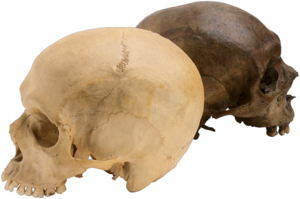More Genes Involved in Obesity

I am impressed by the progress being made by some of my former colleagues who are busily unraveling the complex genetics of obesity.
In a paper in the journal Science a group of British scientists including Chris Ponting of the Medical Research Council Functional Genetics Unit in Oxford and Stephen O’Rahilly’s group at the University of Cambridge, has made a second breakthrough in twelve months in understanding how a gene triggers weight gain in some individuals. In May we looked at the first piece of work on the gene called “FTO.”
At that time we learned that variations in the FTO gene influence people’s risk of becoming obese. This particular gene was of great interest because the genetic variant in FTO that predisposes to obesity is very common in the population.
About half the British population carries a copy of the variant and they are on average 3-4 pounds heaver than those who do not have it. The 16 per cent of the population who carry two copies of the variant and are on average 6-7 pounds heavier. We also learned that carriers of the variant have an increased risk of diabetes. However the function of FTO was completely unknown.
The new paper shows that the FTO gene codes for an enzyme – 2-Oxoglutarate-Dependent Nucleic Acid Demethylase – that can act directly on DNA. This strongly suggests that FTO might have a role in controlling how and when genes are turned on and off.
The investigators also found that FTO is highly expressed in the hypothalamic region of the brain, which has important roles in the control of hunger and satiety. In certain areas of the hypothalamus, the levels of FTO are influenced by feeding and fasting.
This is a remarkable finding. That a gene involved in obesity and diabetes has a direct effect on DNA in specific regions of the brain is very exciting. It suggests that the gene is involved in influencing how well the brain senses hunger and fullness. Small molecules derived from metabolism can modulate the activity of FTO, so we can see a direct link form food to metabolism to DNA in the brain.
The findings raise all kinds of treatment possibilities and also confirm something that I have been teaching for three decades: weight control does not start with a diet. It starts between the ears. Until you have been shown how to re-program your brain, thoughts and emotions, your chance of successfully controlling your weight is, ahem, slim.
Finding Your Ancestors

I think that most of us have at least a little bit of curiosity about our ancestry. Growing up in Europe, most people have quite a good idea where they came from. It is very different in the “New World.”
People here often have deeply personal reasons for wanting to know their ancestry. Some hope to validate genealogical records or fill in gaps in family histories. Others are searching for a connection to specific groups or places in Eurasia or Africa. Many African Americans hope to trace ancestral links lost during the slave trade. Other hope to obtaining Native American tribal affiliation or to challenge tribal membership decisions.
Hence the proliferation of services offering genetic analyses to individuals. And it has become big business.
A quick search on Google just found least two dozen companies who market genetic ancestry tests to help people discover the origins of their ancestors. The tests typically cost between $100 and $900, and in the United States alone it is said that more than 460,000 people have purchased the tests during the past six years.
But there have been lingering doubts about the value and accuracy of the tests.
In “The Science and Business of Genetic Ancestry Testing,” which appears in the today’s issue of the journal Science Deborah Bolnick, assistant professor of anthropology at The University of Texas at Austin and 13 researchers from universities across the country call upon the scientific community to educate the public about the limitations of the tests, and also urge consumers to approach the tests with caution.
The writers argue that the assumptions and limitations of the tests make them less informative than many people realize. Secondly, the rapid commercialization of the tests may have led to misleading practices that reinforce misconceptions.
They make several important points:
- Most tests trace only a few of your ancestors
- Most only test a small portion of your DNA
- Tests are not likely to identify all of the groups or locations around the world where a test-taker’s relatives are found
- When we do genetic research we spend a great deal of time checking and re-checking the accuracy of the tests. But commercial tests may report false negatives or false positives
- Limited sample databases mean test results are subject to misinterpretation
- There is no clear connection between DNA and racial/ethnic identity: the similarities between the races are far greater than the differences
- Tests cannot determine exactly where ancestors lived or what ethnic identity they held
There is also an excellent feature story, entitled “Deep Roots,” that may interest you.
Caveat emptor!
The Genetics of Wall Street

After seeing the recent ups and downs of Wall Street, I was fascinated to see a new study in the Proceedings of the National Academy of Sciences by an international team of researchers that has demonstrated for the first time that genes exert an influence on people’s behavior in a very common experimental economic game.
The Nobel Laureate Jim Watson once quipped that there were only molecules and everything else was sociology. I don’t think that he was being altogether serious, but he did highlight a yawning chasm between different ways of describing human experience.
Social scientists have been a bit reticent about acknowledging a role for genes in economic behavior. But a study by David Cesarini, from the Massachusetts Institute of Technology’s Department of Economics and colleagues in Sweden indicates that there is a genetic component to people’s perception of what is fair and what is unfair.
The researchers looked at the ultimatum game, in which a proposer makes an offer to a responder on how to divide a sum of money. This offer is an ultimatum; if the responder rejects it, both parties receive nothing.
Because rejections in the game entail a zero payoff for both parties, theories of narrow self-interest predict that any positive amount will be accepted by a responder. The intriguing finding in the laboratory is that responders routinely reject free money, presumably because they feel that they want to punish proposers for offers that they think are unfair.
To study genetic influence in the game, the researchers recruited twins from the Swedish Twin Registry, and had them play the game under controlled conditions. Because identical twins share the same genes but fraternal twins do not, the researchers were able to detect genetic influences by comparing the similarity with which identical and fraternal twins played the game.
The results suggest that genetic influences account for as much as 40 percent of the variation in how people respond to unfair offers. This is much larger than the effect of common environmental influences such as upbringing.
The research indicates that many of our preferences and personal economic choices are subject to substantial genetic influence, and it will be interesting to see how they interact with social and environmental factors.
The Neuronal Shield
Sometimes Nature does our experiments for us, and nobody – especially any animals – need to get hurt at all.
Diabetes mellitus is one example, in which heart disease, arteriosclerosis and stroke are many times more common than they are in the general population, and give us a perfect place to start looking at some of the causes of arterial diseases in general.
Another, and far more rare, example is a group of brain diseases called lissencephaly, in which whole layers of the cerebral cortex fail to find their homes and develop. The result is a brain that has a fairly smooth surface, rather than being covered in the complex hills and valleys (“gyri” and “sulci”) that cover the surface of the healthy brain. People with lissencephaly usually have quite severe mental retardation, motor problems, muscle spasms and seizures. What normally happens during embryonic development is that the six main layers of the cerebral cortex are generated by neuronal progenitor cells that migrate long distances before they finally find their correct place and settle down. At the beginning of brain development the cells look like an unruly mob trying to find their seats at a concert. Eventually they find their spot, settle down and get to work. The precise spatial organization of these layers of cells is essential to normal cortical functions.
Though lissencephaly is rare, there are other disorders, including some forms of epilepsy and some types of schizophrenia that also result from abnormal migration of nerve cells during the development of the brain.
Researchers from the Mouse Biology Unit of the European Molecular Biology Laboratory (EMBL) in Italy have now discovered that a protein called n-cofilin, that helps organizing the cells’ skeleton is crucial for preventing such defects. In the current issue of Genes & Development they report that mice lacking n-coffin show many of the classic signs and symptoms of lissencephaly.
The skeleton of a cell consists of constantly growing and shrinking filaments that function like strings and struts to give the cell shape and stability, and it is largely responsible for the migration of neurons in the developing brain. N-cofilin interacts with actin – one kind of skeletal filaments – and helps to disassemble them into their individual building blocks. Interfering with this filament remodeling impairs the cell’s ability to move and that blocks migration of neurons during cortical development.
N-cofilin also controls the fate of neural stem cells that are involved in development of the cortex. If it is absent, stem cells stop moving and re-new themselves instead of differentiating. This imbalance depletes the pool of neuronal progenitors cells so that fewer cells can be made to build a complete and functional cortex. The study provides the first proof that proteins affecting actin filament dynamics are involved in neuronal migration disorders.
It is remarkable that a single gene can be so important in the development of the brain, and it opens up new fascinating possibilities for treatment.
Birth Order, Social Order and Intelligence

For many decades, experts have disagreed about the impact of birth order on intellect, achievement and emotional and cognitive skills.
Some have claimed that first-born children get more undivided attention from their parents and so develop faster and become more cognitively competent.
Others have claimed that birth order might have an impact because of differences in the womb before birth. The idea was that with each subsequent pregnancy the mother produces higher and higher levels of antibodies that may attack the fetal brain.
Other researchers claim that the relationship between birth order and intelligence is false, having been biased by family size. Historically there has been a tendency couples with lower IQs to have more children than couples with higher IQs. But that is also hard to support: there are many cultures and religions in which high IQ couples have many children.
Three years ago, Dalton Conley, a sociologist from New York University and director of the Center for Advanced Social Science Research published a fascinating book, The Pecking Order, in which he used data from the U.S. Census, the General Social Census Survey conducted at the University of Chicago over the last thirty years, as well as a prospective study launched in 1968, at the University of Michigan. He came to the conclusion that siblings diverge widely in social status, wealth and education. We can all remember examples in the news: of a President with a drug using brother and a professor whose brother was a convict. There are scores of other cases like these.
In Dalton’s model, there are genetic, social and birth order reasons for these family inequalities. Most families establish a hierarchy that predicts a child’s success and role within a family. Where you are in that hierarchy is only partly determined by birth order. Dalton argued that what really matters is family size, parental time and attention, and how much of the family’s financial resources are available for the child. His research showed that no single factor could predict success or failure in life. That makes good sense, though when we look at family hierarchies there is likely a strong cultural and ethnic factor at play. In some cultures first-born boys still receive a great deal more favoritism than the other children.
Now a Norwegian team has reported in the journal Science that first born children and those who had lost older siblings and had thereby become the eldest, scored higher on standard tests of intelligence. The IQ difference that they found in their study groups was small but significant.
The link was found by Professor Petter Kristensen at the National Institute of Occupational Health in Oslo, and Tor Bjerkedal at the Norwegian Armed Forces Medical Service who looked at more than 250,000 male Norwegian conscripts.
What they found in this large all male group was that it is the son’s social position in a family rather than his biological position that counts toward his intelligence.
For example, if a man was born third but then lost an elder sibling in early childhood, he would normally be raised as if had been born second. And his IQ as an adult would tend to be close to that of “genuine” second-borns.
It is going to be interesting to see whether there is a similar effect in girls, since they tend to grow up more quickly than boys.
The fact that the death of an older sibling “moves the child up” the IQ rankings is against something going on in the womb.
There are several possible reasons for this effect. More mature children often tend to become a surrogate parent. And because he or she is still young they will tend to become very conscientious, mature and self-disciplined. You have probably seen or known of a child who had to do a lot of growing up very quickly after the death of, or abandonment by, a parent.
Another possibility is that a first-born gets smarter because he or she tutors the younger siblings.
A complicating factor in this research is when a child “moves up” because of the death of an older sibling, the shock of losing a child may lead the family to expend even more care and attention on the surviving children, particular those most likely to be able to take over if anything happens to the parents.
And the other point I something that I have discussed before. There are genes that predispose you to having a certain type and degree of intelligence. But social and environmental factors continue to have a powerful impact.
I just read an article in which the parents of some mentally ill people were declaring that new research on the social triggers to mental illness was a waste of time, and that the “Answer” must be biological.
It is rarely that simple: genes, epigenetic factors, nutrition, personal experience and the social and emotional environment all need to be put into the mix if we want to understand why someone is the way that they are, and how we can help them to fulfill their potential.
Resistance Genes in the Food Supply

Your humble reported has been interested in nutrition since he was knee high to a puppy, and he has also been worried about the consequences of pesticides and other artificial chemicals getting into the food chain. He has also been worried about feeding all kinds of artificial potions to animals. Surely they would eventually turn up in humans, and we have little idea about all the things that they may do. It is also a worry that antibiotic resistance in humans could be passed on to bacteria in animals.
Some of these fears were born out at a conference – the 107th General Meeting of the American Society for Microbiology (ASM) – in Toronto this week.
A paper presented by Hua Wang of the Ohio State University suggests that the administration of antibiotics to animals could be contributing to the continuing rise of antibiotic-resistant infections in humans
The problem is a process known as horizontal gene transfer, in which bacteria that are in close proximity to each other can share genetic information, including genes that code for antibiotic resistance. Horizontal gene transfer between disease-causing bacteria has been known for years as an important avenue for the exchange of antibiotic-resistance genes among bacteria in hospitals. We all carry bacteria on and in our bodies. Some are beneficial, and help in things like digestion. Others are simply “passengers,” and we call these “commensal” bacteria.
Research has also already demonstrated that pathogenic bacteria have the ability to engage in horizontal gene transfer with the otherwise harmless bacteria that we all carry in our bodies. What concerns us is that these normally benign commensal bacteria have an enormous and diverse gene pool. That increases the likelihood of gene transfer. Some commensal bacteria exchange genetic information extremely quickly. That was helpful to the bacteria during evolution, but may be producing a boatload of problems for us today.
Dr Hua said:
“We have demonstrated not only that organisms carrying such intrinsic mechanisms have the potential to become an important reservoir for antibiotic resistance genes but, more importantly, that these intermediate organisms can disseminate antibiotic resistance genes in subsequent events much more effectively than the parental donor strain.”
“Once we no longer limit ourselves to food borne pathogens and look at commensal bacteria, we will find that the magnitude of antibiotic-resistant bacterial contamination in the food chain is tremendous.”
In a study published last year, she and her colleagues tested a range of ready-to-eat food samples that they purchased from several grocery chain stores. They included seafood, meats, dairy, deli items and fresh produce. With the exception of processed cheese and yogurt, antibiotic-resistance gene-carrying bacteria were found in many food samples that they examined.
The problem is not just confined to the food supply. Recent studies have shown antibiotic resistance genes in bacteria in the digestive tract of young infants. Since these children were still being breast- or formula-fed and had not yet eaten solid food, they must have acquired these genes somewhere other than the food supply. This suggests that resistance genes from the environment had somehow got into the infants.
Antibiotic resistance is a huge and ever-growing problem. For years now, many of us have worried about the over-prescribing of antibiotics when they are not needed. For example viruses cause the vast majority of sore throats, and few viruses respond to antibiotics. Yet patients often feel cheated if they do not leave a doctor’s office clutching a prescription. The result has been increasing numbers of resistant bacteria. When you really need an antibiotic, it may no longer be effective. Now we have another mechanism by which our actions have caused a problem that could quite literally be the death of us.
Genes, Geography and Culture

The science bug bit me early in life. As a young schoolboy I was fascinated to read the exploits of explorers and collectors. Charles Darwin’s amazing adventures were stirring stuff to a teenager.
The other day I was thinking about all those books that I read after I spotted an interesting article in the Daily Telegraph by Professor Steve Jones, who is a geneticist at University College London, and someone who always makes you think.
Bob Geldof – he of the Boomtown Rats and Live Aid fame – has set up an ambitious project to map cultural differences around the globe before the peoples of the world sacrifice their cultural individuality on the altar of Western consumerism, blue jeans and cell phones.
Anyone who travels as much as I do cannot help but be dismayed at the cultural homogenization that’s happened over the last 25 years. A bit jet lagged, I once woke up in a hotel in the wee small hours and called the front desk to ask which country I was in. I had been in seven in the last two days and there were no clues as to my location when the chauffeur dropped me off just before midnight. It turned out to be Switzerland and the man at the desk told me that it was a common question.
Although I lament the loss of cultural identity, it is not all bad. But it raises some very interesting questions.
While Bob is recording vanishing cultures, geneticists are trying to establish which behavior is determined by DNA and which by our environment.
Steve Jones was meditating on the question of whether local changes in customs inborn or learnt. My schoolboy hero Darwin was also interested in that question and set out to discover whether expressions of fear or joy varied from place to place. The idea was that they might if they were passed on culturally rather than genetically. He corresponded widely on the subject and Steve reminded me of something that I had not read in 30 years:
“Mr. B F Hartshorne… states in the most positive manner that the Weddas of Ceylon never laugh. Every conceivable incitive to laughter was used in vain. When asked whether they ever laughed, they replied: ‘No, what is there to laugh at?”
Darwin finally concluded that expressions of happiness or anger were universal. They had, he thought, evolved, because he fancied that he could detect hints of human laughter in the grin of a tickled chimpanzee.
Some behaviors have a genetic basis. The absence of cheese and milk from Chinese cuisine is normally attributed to the few cows in the country, or the influence of traditional Taoist notions of what items may appear in the same space. But it may have just as much to do with the high rates of lactose intolerance amongst Chinese populations. The Scots have a high frequency of a gene that makes it easier for them to digest cows’ milk, so milk – sometimes cleverly disguised – seems to appear on almost every Scottish menu.
There is an interesting sidebar here. A recent study that analyzed DNA in Neolithic human remains seems to have uncovered the first direct evidence that modern humans have evolved changes in response to natural selection.
According to a new analysis of fossilized bone samples, as recently as 7000 years ago, Europeans were unable to digest milk. Today more than 90% of the Northern European population can. It is most likely that Europeans incurred a rapid change in their genetic make-up because it held an evolutionary advantage for them to be able to digest milk.
Lactose is a sugar in milk, and around the world the majority of humans lose the ability to digest it before reaching adulthood. This is because their gene for the enzyme lactase, that is responsible for breaking down lactose, is switched off by late adolescence. However, over 90% of northern Europeans have a version of the lactase gene that remains active throughout life, enabling them to continue drinking milk as adults. This genetic change appears to have happened around 7,000 years ago and spread rapidly. In the climatic conditions of the time, milk drinking could have conferred a huge survival advantage: unlike water, milk in usually uncontaminated by parasites, and is available year round, unlike seasonal crops. Milk also contains vitamin D and calcium, and in the dim sunlight of Northern Europe, where people may not be able to make enough vitamin D in their bodies, making calcium absorption difficult. Milk would have solved both problems.
So what we might be seeing here is an environmental factor changing gene expression, which in turn has a social and cultural outcome.
Steve Jones’ article talks about some other cultural differences that may have genetic roots. One very recent study purports to show that the number of sexual partners of American male (but not female) college students is related to variation in a gene called dopamine transporter gene (DAT1). The gene codes for a dopamine transporter protein that limits the level and duration of dopamine receptor activation. It is a strong candidate gene for reward-seeking behavior. Dopamine is known to be involved in the reward or “salience” systems of the brain and is known to influence sexual behavior in mice.
The DAT1 gene comes in two distinct forms. Young men with a single or double copy of one of the variants have, it is claimed, twice as many sexual partners on average as do those with a double hit of the different and less common form of the gene. The latter group, about one young man in 10, are far less romantically daring than average. They are also less likely to be involved in drug abuse or to get in trouble with the law. Research like this is complex. To quote Gregory House, “People lie.” And when it comes to doing research on sexual behavior they lie a lot. And it is a fool’s game to try and reduce human behavior to a single gene. I am sure that if you think about it for a moment, you can come up with at least a dozen reasons why people are likely to have more sexual partners.
Levels of promiscuity vary greatly from place to place. There has been a myth circulating that the AIDS pandemic in Africa is caused by promiscuity. In fact there is less promiscuity in Africa than in the West. It is no surprise that young people less sexually active in Bangladesh than in Britain. For years now, anthropologists have speculated about what lies behind these variations, from the wild and socially sanctioned polygamy of a few males in certain ancient – and some not so ancient societies to the modern Western practice of serial (and approximate) monogamy. Recently researchers have begun to ask whether the differences might be due to genetics rather than the ownership of land or cattle, or social or religious mores.
The American DAT1 study shows that although DNA might have a strong effect on the behavior of individual men, it is unlikely to be responsible for cultural differences in sexual behavior. The students in the study were classified as of European, Black, and Asian or Hispanic origin. There are problems about racial classification: few are clear-cut. We are most of us far more mixed than some people would like to believe. The overall frequencies of the two variants were roughly the same within each ethnic group; and within each seemed to have the same effect. The Asian Americans, though, had fewer than half as many partners compared with the others. Social differences, that were most likely imported by their families from the sexually restrained populations of their native lands, overwhelmed any effects of the DNA.
For anyone interested in the complex interactions of genes, the environment, the psyche and culture, this study is yet another nail in the coffin of genetic determinism: that you are the victim of your genes.
Most mice and chimpanzees behave in much the same way from place to place. Yes, there are some subtle differences here and there, but as a general rule, and English mouse and a Chinese mouse will behave in much the same way. But humans show enormous cultural variation. But here is the paradox: at the genetic level we are the most boring of creatures. Yes, there is some genetic variation form place to place, and certain genes are more active, depending on environmental and cultural factors. Just think milk drinking and skin color. Human social diversity is matched by genetic homogeneity: the overall DNA difference between an American and a Chinese is less than that between two groups of chimpanzees living 100 miles apart in Africa.
Though our cultures have evolved over the centuries, it an evolution of mind rather than genes.
Breast Cancer and the Gang of Four
People of a certain age will remember the ominous "Gang of Four" who were primarily blamed for the events of the Cultural Revolution in China.
Now new research published in the journal Nature has exposed an equally ominous "Gang of Four," but this time it is a set of four genes is responsible for the lethal spread of breast cancer.
A team in New York with researchers now working at the Hospital Clinic de Barcelona and the Institute for Research in Biomedecine in Spain, has identified four key genes in human breast cancer cells that play a role in metastasis, or the spread of the cancer, to the lungs.
A number of genes are already known to contribute to the spread to the lungs. But Prof Joan Massagué and colleagues at Memorial Sloan Kettering Cancer Centre, New York, now show how four co-operate to promote the formation of new tumour blood vessels, the release of cancer cells into the bloodstream, and the penetration of tumour cells from the bloodstream into the lung.
The gene set comprises EREG, MMP1, MMP2 and cyclooxygenase (COX2). (That is the same COX2 that you will have heard about as a target for some arthritis and anti-inflammatory medicines. It is the abnormal activation of all four that enables the breast cancer to invade the lungs. Although shutting off these genes individually can slow cancer growth and metastasis, the researchers found that turning off all four had a dramatic effect.
Prof Massagué said:
"The remarkable thing was that while silencing these genes individually was effective, silencing the quartet nearly completely eliminated tumour growth and spread."
In experiments on human breast tumours implanted in mice, the researchers also found that they could reduce the growth and spread of the disease by simultaneously targeting two of the proteins produced by these genes, using drugs already on the market.
"We found that the combination of these two inhibitory drugs was effective, even though the drugs individually were not very effective," said Prof Massagué. "This really nailed the case that if we can inactivate these genes in concert, it will affect metastasis."
The researchers now want to test combination therapy with the drugs – cetuximab (Erbitux) and celecoxib (Celebrex) – to treat breast cancer metastasis.
The other two genes are matrix metalloproteinases (MMP1 and MMP2) that are involved in the formation of new blood vessels.
A second study, also published in Nature, reports that investigators in Texas have isolated 87 genes that seem to affect how sensitive human cancer cells are to certain chemotherapy drugs.
The study highlights a new way to screen for alterations in cancer cells that make them specifically sensitive to treatments, so that they may leave normal tissue relatively unharmed.
This is important work that unlocks another piece of the mystery of at least one type of cancer.
It will not be the whole story: we still need to find out why tumors can spread to other organs and how environmental factors, including states of mind, may have an impact on the spread of tumors.
And it is yet more evidence that inflammation is one aspect of the spread of tumors.









